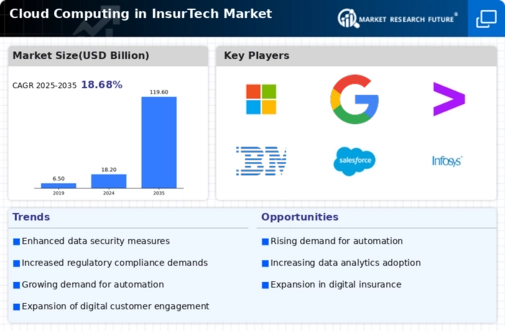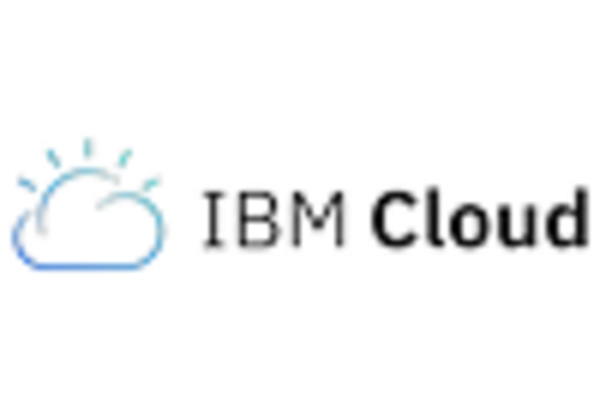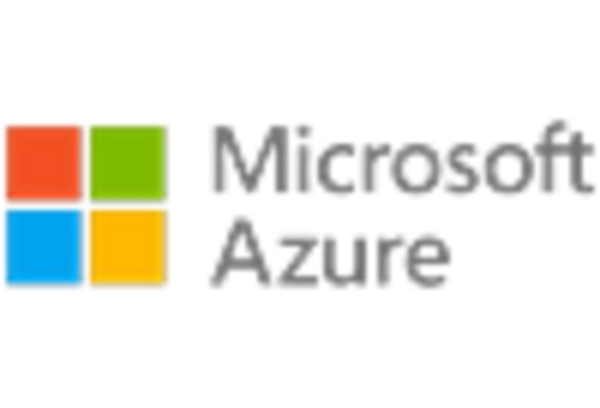Enhanced Customer Experience
The Cloud Computing in InsurTech Market is witnessing a paradigm shift towards enhanced customer experience. Insurers are increasingly leveraging cloud-based solutions to provide personalized services and streamline claims processing. This shift is driven by the need for real-time data access and analytics, which enable insurers to tailor products to individual customer needs. According to recent data, companies utilizing cloud technologies report a 30% increase in customer satisfaction scores. The ability to quickly adapt to customer feedback and preferences is becoming a critical differentiator in a competitive landscape. As a result, the focus on customer-centric solutions is likely to propel the growth of cloud computing within the InsurTech sector.
Cost Efficiency and Scalability
Cost efficiency remains a pivotal driver in the Cloud Computing in InsurTech Market. Insurers are increasingly adopting cloud solutions to reduce operational costs associated with traditional IT infrastructure. By migrating to the cloud, companies can scale their resources according to demand, thus optimizing their expenditure. Reports indicate that organizations can save up to 25% on IT costs by utilizing cloud services. This financial flexibility allows insurers to invest more in innovation and customer service enhancements. Furthermore, the scalability offered by cloud computing enables insurers to quickly respond to market changes and customer demands, fostering a more agile operational model.
Integration of Advanced Technologies
The integration of advanced technologies is a significant driver in the Cloud Computing in InsurTech Market. Insurers are increasingly adopting cloud platforms to facilitate the integration of technologies such as artificial intelligence, machine learning, and big data analytics. These technologies enable insurers to enhance risk assessment, improve underwriting processes, and optimize claims management. The synergy between cloud computing and these advanced technologies is expected to create new opportunities for innovation within the InsurTech sector. As organizations seek to harness the power of data, the demand for cloud-based solutions that support these integrations is likely to rise, further propelling market growth.
Collaboration and Ecosystem Development
Collaboration and ecosystem development are emerging as key drivers in the Cloud Computing in InsurTech Market. Insurers are increasingly partnering with technology providers, startups, and other stakeholders to create comprehensive solutions that address evolving customer needs. This collaborative approach fosters innovation and accelerates the development of new products and services. The rise of InsurTech hubs and innovation labs is indicative of this trend, as they facilitate knowledge sharing and resource pooling among industry players. As the ecosystem matures, the demand for cloud-based platforms that support collaboration is expected to grow, thereby enhancing the overall landscape of the InsurTech market.
Regulatory Compliance and Data Security
In the Cloud Computing in InsurTech Market, regulatory compliance and data security are paramount concerns. Insurers are required to adhere to stringent regulations regarding data protection and privacy. Cloud solutions provide advanced security features, such as encryption and access controls, which help organizations meet compliance requirements. The increasing frequency of data breaches has heightened the focus on security, with studies showing that 60% of insurers consider data security a top priority. As regulatory frameworks evolve, the ability of cloud providers to offer compliant solutions will likely influence insurers' decisions to adopt cloud technologies, thereby driving market growth.


















Leave a Comment